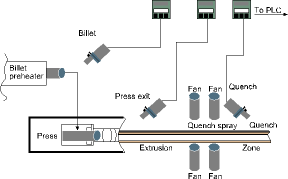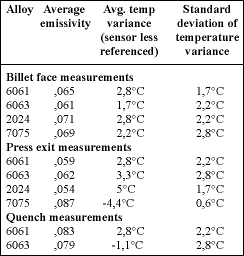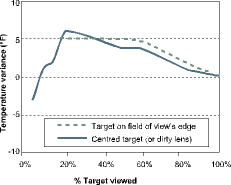
Infrared non-contact temperature sensors are used routinely for temperature control in industrial processes involving steel, glass, paper, and plastic. This has not been the case for aluminium extrusion because, until recently, obtaining an accurate and reliable non-contact temperature measurement of aluminium has been cumbersome and inconvenient. Aided by powerful advances in microprocessor technology, a new generation of infrared temperature sensors has been developed that offers significant increases in sensor accuracy, reliability, and ease of use over original designs. These improvements have resulted in wide acceptance of infrared non-contact temperature sensors by the aluminium extrusion industry.
Aluminium extrusion is a metal forming process that transforms aluminium stock into a finished product with specific dimensional, metallurgical, and aesthetic properties. The attainment of these desired properties requires achievement of specific metal temperatures at critical points throughout the process. Critical temperatures include billet temperature at the entry to the container, profile temperature at the exit of the platen, and (when applicable) profile temperature after quench. Efficient extrusion operations recognise the need to maintain these critical temperatures in their quest to maximise throughput and minimise scrap.
Maintaining critical process temperatures requires direct feedback from temperature-monitoring devices. Contact thermocouples have been the traditional device for temperature information gathering. However, thermocouples are not ideal because, depending on the application, they can be discontinuous, inaccurate, and maintenance-intensive.
Non-contact pyrometers for aluminium extrusion
An aluminium extrusion plant requires a temperature sensor that is able to contend with several difficult application issues. An ideal temperature sensor would provide continuous readings that are not affected by changes in alloy, emissivity, surface roughness, surface oxidation, profile shape, profile size, or profile position. In addition, the sensor would provide maintenance-free operation and possess the versatility to measure aluminium temperatures at the press exit, in the quench zone, and at the entrance to the container (Figure 1).

Original non-contact temperature sensors for aluminium extrusion applications used analog circuitry-based algorithms to compensate for the emissivity irregularities of aluminium, but they did not adequately address the other application issues. Early sensors required significant maintenance and were difficult to use. Although the typical soft-alloy extruder could improve plant productivity by 20 to 30% with the incorporation of continuous press exit temperature feedback, most plants were unwilling or unable to provide the exceptional level of support required for proper operation of the early sensor designs. "Those old sensors were a pain in the neck!" says Dave King of ALCOA, "We could make them work, but the operators were making adjustments, cleaning the lens, and fixing the alignment several times a shift."
Advances in sensor technology
Advances in microprocessor speed and memory have spawned a new generation of non-contact temperature sensors that are able to provide accurate readings of aluminium under diverse operating conditions. Versatile digital algorithms allow optimisation of sensor performance for several applications and virtually eliminate the need for routine sensor maintenance.
Some new temperature sensors for aluminium are supplied with a general-purpose algorithm that must be 'taught' the infrared fingerprint of the particular installation. These sensors are able to recognise when their algorithm is 'out of bounds,' and users can 'teach' the sensor as conditions dictate. In other words, the sensor is able to 'learn' the process conditions over time. Other more versatile sensors are pre-loaded with robust algorithms that are applicable to entire families of applications. For example, select sensors include pre-loaded algorithms for press exit, quench, sheared-face billet, and cut-face billet measurements.
Comparing the two approaches, the pre-programmed sensor is easier to use because, once the appropriate application algorithm is selected from the sensor's menu listing, no additional operator involvement is required for fine-tuning. Shaun Armstrong, of Cardinal Aluminium agrees: "I was very impressed with the [pre-programmed] sensor. It was more stable and accurate right out of the box than the [field-programmed-type] was after a two-day set-up and weeks of adjustment." In either case, the new generation of aluminium temperature sensors is able to account for all of the most significant application issues that have prevented the wide acceptance of taking continuous aluminium temperature measurements at points throughout the extrusion process.
Demonstrated accuracy and versatility
Field data supports claims from sensor manufacturers that accurate readings are obtainable over a wide range of conditions. Table 1 provides typical accuracy values for billet, press exit, and quench measurements across several alloys. The data indicates that it is reasonable to expect readings within less than 5,5°C of an accurate and properly used reference thermocouple across 6xxx, 2xxx, and 7xxx alloys, no matter whether it is a billet, press exit, or quench measurement.

One other shortcoming of the early temperature sensors for aluminium extrusion is that inaccurate readings were generated when the sensor lens was dirty or when the sensor was aligned to a small or wandering extrusion profile. New sensor designs are able to compensate for these conditions. Figure 2 demonstrates the relative insignificance of misalignment or a dirty lens to the accuracy of the sensor readings. With only 20% of the sensor field of view filled by the profile, the sensor exhibits less than a 3,3°C offset.

Extrusion personnel further support manufacturer's claims of superior accuracy and versatility under diverse application conditions. Ziad Amary of Aluminium Shapes, USA, witnessed temperature readings from a pre-programmed sensor within 2,2°C of a reference thermocouple probe on three different profile shapes, each a different alloy, without any adjustments to the sensor. "Finally," he said "an aluminium temperature sensor that does not need constant adjustment." Commenting on the versatility of a new generation aluminium sensor, Yuji Fuji of YKK said, "I could not make the thing read wrong!"
Additional conveniences
Several other features are included to make day-to-day sensor operation easier. Some sensors are equipped with built-in laser alignment and a user interface module that uses plain English to direct the user through the sensor settings. Built-in system diagnostics, as well as outputs of product temperature, emissivity value, sensor ambient temperature, and the signal dilution factor provide abundant operating and troubleshooting conveniences.
Conclusion
Manufacturers have made tremendous strides towards making non-contact infrared temperature sensors easy to use for aluminium extrusion applications. Dave King of ALCOA concludes, "Infrared technology has finally improved to the point where we do not have to be infrared experts to use the equipment and we can focus on our core business - making aluminium." The continuous measurement of extruded profile, quenched profile, and billet entry temperatures in the aluminium extrusion industry is now easier than ever.
| Tel: | +27 11 791 6000 |
| Email: | [email protected] |
| www: | www.tempcon.co.za |
| Articles: | More information and articles about Temperature Controls |

© Technews Publishing (Pty) Ltd | All Rights Reserved